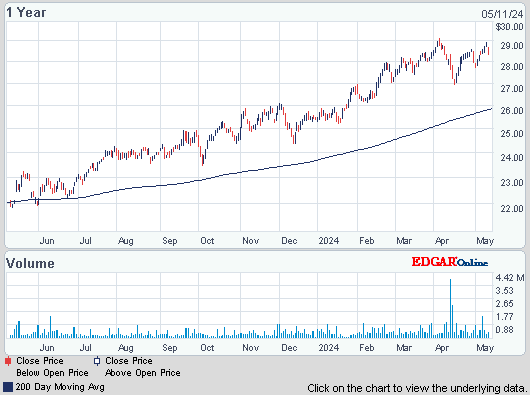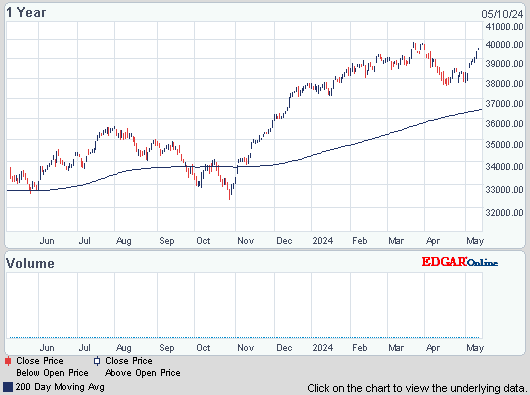Dow jumped 92, advancers over decliners 2-1 & NAZ climbed 29. The MLP index lost 2+ to 460 (down about 10 from setting a new record high) while the REIT index was off fractionally in the 282s. Junk bond funds inched higher & Treasuries were mixed to lower. Oil slipped from a 4 month high as the Energy Information
Administration said US inventories climbed. Gold closed lower for a 2nd straight session,
pressured by weak Chinese manufacturing data as well as a strength in
the US dollar.
AMJ (Alerian MLP Index tracking fund)

![Live 24 hours gold chart [Kitco Inc.]](http://www.kitco.com/images/live/gold.gif)

Photo: Bloomberg
Photo: Bloomberg
The rate of new foreclosures in the US dropped to the lowest level in 8 years as rising property prices erased negative equity & allowed more delinquent homeowners to sell without losing money. The share of loans on which foreclosure actions were started declined in Q4 to 0.54% from 0.7% a year earlier, the Mortgage Bankers Association said. The rate was the lowest since Q3-2006, when home prices were just starting to fall in what would become the worst crash in decades. The foreclosure crisis is fading for much of the country as the economy improves & Americans negotiate with banks for modifications or approval to sell for less than what’s owed. Home prices rose 11% in Dec from a year earlier, the 22nd straight increase, CoreLogic reported. “Foreclosures are back to the typical historic range,” said Michael Fratantoni, chief economist for the Mortgage Bankers Association, said. “The vast majority of loans that remain to be worked out are very old at this point.” About 75% of seriously delinquent loans in Q4 originated in 2007 or earlier. The rate of foreclosure starts peaked in 2009 at 1.42%. Since then, low mortgage rates & tight inventories have helped provide a foundation for the housing recovery. The mortgage-delinquency rate fell to 6.39% in Q4 from 7.09 % a year earlier. The percentage of loans in the foreclosure process dropped to 2.86% from 3.74% a year earlier. Both figures were the lowest since 2008.
Foreclosure Starts Fall to Pre-Crisis Levels as Home Prices Rise
The Ukraine situation is getting very ugly & the EU slapped sanctions on the country. Venezuela is dealing with protests. The euro & Chinese economies are fragile to some degree. Then there is the US. By comparison, this economy looks fairly healthy after the slowest growth from a recession (in a very long time). But the leading indicator data was drab, measuring what is lagging data. Stocks didn't mind. Even the high yielding sectors have been doing well this year. But new information is coming shortly & that may not be appreciated.
Dow Jones Industrials

AMJ (Alerian MLP Index tracking fund)
Treasury yields:
U.S. 3-month |
0.05% | |
U.S. 2-year |
0.32% | |
U.S. 10-year |
2.76% |
| CLH14.NYM | ...Crude Oil Mar 14 | ....102.96 | (0.3%) |
![Live 24 hours gold chart [Kitco Inc.]](http://www.kitco.com/images/live/gold.gif)

Photo: Bloomberg
The index of US leading indicators
climbed in Jan, an indication the economy will bounce back
after winter storms damped economic growth in early
2014. The Conference Board’s gauge of the outlook for the next 3-6 months rose 0.3% after no change in the
prior month,
matching the forecast. Higher equity prices & home values last year have helped
bolster household wealth, giving Americans the means to sustain
spending after a winter-related slowdown. A pickup in job &
wage growth following a decline in dismissals would provide an
added spark for consumers purchases. 5 of the 10 indicators in the leading index contributed
to the increase, today’s report showed. They included a drop in
jobless claims & a pickup in factory orders. Declines in
building permits & hours worked weighed on the measure. The index of coincident indicators, a
gauge of current economic activity, rose 0.1% for a 2nd month. That index covers payrolls, incomes, sales &
production, measures used by the National Bureau of Economic Research to determine when recessions start & end. The gauge of lagging indicators increased 0.3%.
Photo: Bloomberg
The euro-region recovery showed
signs of cooling this month, with weaker-than-forecast
manufacturing & services keeping pressure on the ECB to loosen policy. The factory gauge for the euro region unexpectedly slipped
to 53 from 54 in Jan, while the services measure rose less
than estimated to 51.7 from 51.6, Markit Economics reported. A
composite gauge fell to 52.7 from 52.9. These figures follow a
report from China showing manufacturing growth slowed to the
least in 7 months. While the euro-area economy is forecast to post full-year
growth in 2014 for the first time in 3 years, the recovery
remains at risk because of near-record unemployment & subdued
price pressures. ECB officials are debating
whether they should ease policy further because inflation is
less than half the 2% the ECB defines as price stability. Spain still paid the least since 2006 to borrow for 10
years today in a sign of appetite from foreign investors for
debt from nations emerging from Euro bailout programs. The
Spanish Treasury paid 3.56% to investors. The last time
it borrowed so cheaply, the economy was growing 4% a
year, public debt was 40% & a property boom was
approaching its peak. Markit’s report for Germany
showed that a manufacturing index fell more than forecasted in Feb, dropping to 54.7 from 56.5. A services
index increased to 55.4 from 53.1 & a composite index rose to
56.1, a 32-month high. In France, both manufacturing & services gauges
unexpectedly declined, with the latter at a 9 month low.
The rate of new foreclosures in the US dropped to the lowest level in 8 years as rising property prices erased negative equity & allowed more delinquent homeowners to sell without losing money. The share of loans on which foreclosure actions were started declined in Q4 to 0.54% from 0.7% a year earlier, the Mortgage Bankers Association said. The rate was the lowest since Q3-2006, when home prices were just starting to fall in what would become the worst crash in decades. The foreclosure crisis is fading for much of the country as the economy improves & Americans negotiate with banks for modifications or approval to sell for less than what’s owed. Home prices rose 11% in Dec from a year earlier, the 22nd straight increase, CoreLogic reported. “Foreclosures are back to the typical historic range,” said Michael Fratantoni, chief economist for the Mortgage Bankers Association, said. “The vast majority of loans that remain to be worked out are very old at this point.” About 75% of seriously delinquent loans in Q4 originated in 2007 or earlier. The rate of foreclosure starts peaked in 2009 at 1.42%. Since then, low mortgage rates & tight inventories have helped provide a foundation for the housing recovery. The mortgage-delinquency rate fell to 6.39% in Q4 from 7.09 % a year earlier. The percentage of loans in the foreclosure process dropped to 2.86% from 3.74% a year earlier. Both figures were the lowest since 2008.
Foreclosure Starts Fall to Pre-Crisis Levels as Home Prices Rise
The Ukraine situation is getting very ugly & the EU slapped sanctions on the country. Venezuela is dealing with protests. The euro & Chinese economies are fragile to some degree. Then there is the US. By comparison, this economy looks fairly healthy after the slowest growth from a recession (in a very long time). But the leading indicator data was drab, measuring what is lagging data. Stocks didn't mind. Even the high yielding sectors have been doing well this year. But new information is coming shortly & that may not be appreciated.
Dow Jones Industrials
I’m a huge fan of INO & from what I have seen so far, their service Marketclub! This isn’t a stripped down version, everything in MarketClub is available to you. I don’t want to give everything away, but you’ll have unlimited access to my favorite 3 tools: Trade Triangles, Smart Scan & Alerts!
The best part is that the MarketClub customer support team will be providing UNLIMITED support!
You can call or email for an instant response to any question, comment or concern.
Here’s that link:
https://club.ino.com/join/specialtrial/index_free.html?a_aid=CD3289&a_bid=359ef9a3
I’d recommend you jump on this now.










No comments:
Post a Comment